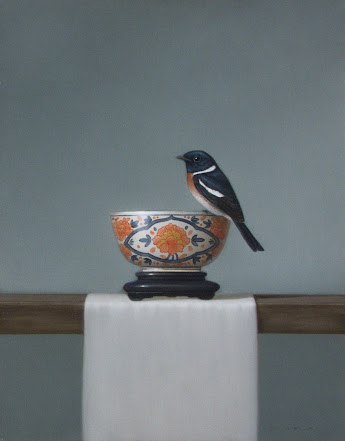Stillness. In our busy-busy world, most of us crave it, yet rarely find it. (The proliferating of meditation apps is just one expression of our yearning.) Fortunately, the painter Sarah Siltala captures stillness on a regular basis, and now we get to discover how she has explored this theme over the past year or so. As this exhibition suggests, most of her attention has been paid to still life paintings that depict an array of birds, fruits, fabrics, flowers, and other foliage, and also to serene landscapes under placid skies. Somehow all of her creations resonate as both traditional and very much of our time.
Our eyes turn first to the “props” in Siltala’s set-ups because we humans instinctively seek out clues and cues. This artist was raised by artist-parents, and her father painted birds, fish, flowers, and other wildlife onto his own ceramics, drawing particular inspiration from the intricate patterning of Persian pottery. In his daughter’s scenes, we more often see East Asian bowls—also densely patterned—and surely it won’t surprise us that she now collects ceramics for herself. In the 17th century, Dutch still life painters included (expensive, imported) ceramics as markers of wealth and aesthetic sophistication. Today we see them not only as gorgeous, but also as signifiers of fragility; no matter how well made, a porcelain bowl can easily be broken, and so it must be protected.
The same can be said
of the birds Siltala depicts. Avian populations are in steep decline
everywhere due to climate change and human encroachment, so we must do
everything possible to keep them alive. Siltala loves watching and
photographing their beautiful vitality outdoors, and in the paintings,
we can immediately discern her understanding of their anatomy and
plumage. At first, the juxtaposition of bird and bowl makes little sense
and might seem a bit surreal (“Why is a bird in your dining room?”),
but soon we slow down to ponder the vulnerability that an innocent
creature would feel outside its natural environment, in a setting so
clearly man-made and potentially hostile. The connections between our
fragility and theirs are closer than we might imagine; Siltala’s
arrangement conveys this unifying idea without preachiness.
It is our minds—more than our eyes, actually—that ascertain the still, meditative aspect of Siltala’s compositions. The artist seeks “to capture the most feeling with the least amount of busy mark making,” and indeed her paintings are, to a degree, studies in empty space charged with a subtle yet powerful tension: we are witnessing that brief moment when a bird—or a butterfly, in one picture—alights in a non-natural setting. We know it will lift off imminently, so we intuitively appreciate—relish even—the preciousness of this instant. Were there no creature at all, the scene would be lovely, yet we might not savor it as thoroughly. Now, in this fleeting moment, every detail matters a bit more.
Viewers may be surprised to learn that Siltala is self-taught, but surely not that she is always teaching herself more about the intricacies of oil painting. Inspired by Old Master traditions, she has even made her own oil paints from pigment and hand-washed linseed oil. With every picture, she sustains the longstanding practice of building thin layers of paint one upon the other; it demands patience because each layer must dry completely before the next can be applied. Pushing further with glazes and scumbles, Siltala achieves a luminosity and a depth that maximizes the play of light and shadow, pleasing our eyes with gem-like colors but not distracting us from the overall sense of unity and stillness.
Getting all of this right is not easy, and it’s a pleasure to watch how Siltala—like a composer of music—explores her variations on a theme, never losing sight of the tranquility she seeks.
Peter Trippi
Editor, Fine Art Connoisseur Magazine
July 2022




%20and%20Pear%2012x9.JPG)















































